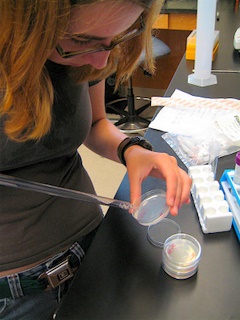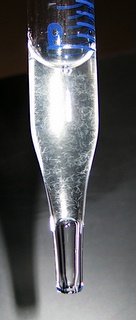Freezing Protocol
Compiled from various originals
Reagents:
Note: reagents are noted per plate. However, to maximize the chance of successfully defrosting the worms, 4-6 freshly starved plates containing lots of L4s are needed.
- S buffer - 2.0 ml
- S buffer + 30 % glycerol
Procedure:
- Add 2.0 ml of S buffer to the first plate. Make sure to cover the entire plate.
- Using a sterile glass pipette, pipette the liquid up and down once. It is important that you get most of the liquid out of the plate. This is most easily accomplished by tilting the plate. Figure 1
- Transfer the liquid to the next plate and repeat the process again.
- Continue to repeat the process for all subsequent plates. You should be able to see the worms collecting in the pipette tip. Figure 2
- Pipette 0.5mL into 1.5mL centrifuge tubes (Fisher Scientific, 130331599). Do so until all the liquid is evenly dispersed.
- Add 0.5mL of S buffer + glycerol solution to each new vial.
- Put vials on ice for 10 minutes.
- Tap vial to resuspend worms that have settled at bottom
- Store vials at -80°C.
NOTE: It is recommended that when freezing a strain, you make an extra vial to defrost after a day or two. This is done to test that the freezing was successful.
Figures
Figure 1. If you tilt the plate to the side, it makes it easier to pipette the liquid again.
Figure 2. You should be able to see the worms collecting in the pipette as you continue the protocol.



